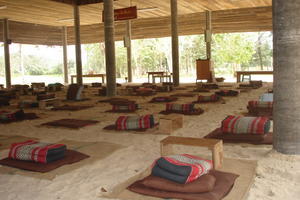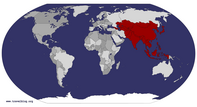Advertisement
Published: February 24th 2007

 The Meditation Hall
The Meditation Hall
This is where we did our 14 hours of sitting meditation.A Meditation Retreat at a Thai Budhist Monastery
January 31- February 3, 2007
Part I: Getting to the Meditation Retreat
Jan 31, 2007
We awoke at 5:30am on January 31 to ensure that we arrived early at the monastery to register. Registration often closes by noon. The monastery was located about an hour's drive outside of Surat Thani. At 6:30am we left our hotel with 2 other people who were also planning to attend the retreat. Once again, we encountered difficulties in getting transportation. We hired a taxi to take us to the government bus station. Instead, he took us to a private bus/min-van company. The taxi driver refused to take us to the government bus station unless we paid an exhurbent amount of money. We attempted to argue, but the both the taxi driver and the owner of the bus owner got very angry. To avoid a street brawl, we succumbed to buying tickets from the bus owner.
Once again we had been scammed. There were 11 of us in the mini-van bound for the monastery. We all paid anywhere from 70-250 Thai Baht for the same trip. A government bus ticket would have been 25 Baht.

 Our Bed!
Our Bed!
Yes, we slept on the table covered by a straw mat and used the wooden pillowPart II: What is a Meditation Retreat?
A Buddhist monastery outside of Chiya, Thailand, runs a public meditation retreat during the first 10 days of every month. Participants are required to register at the monastery the last day of the previous month.
During the 10-day retreat, participants are forbidden to talk or engage in other forms of communication. Participants learn to focus on the "here and now" by meditating. Meditation is done through deep breathing. Meditation allows one to let go of the worries of the past and the anxieties of the future thereby freeing oneself from suffering and stress. The result is that one's mind becomes more calm, relaxed, and peaceful.
Part III: The Rules
Participants must strictly abide by the following rules during the 10-day retreat:
1. Maintain complete silence. No talking, writing notes, sign language, etc. Smiling is acceptable.
2. Refrain from destroying all forms of life, including mosquitoes, spiders, etc.
Translation: I had great difficulties not destroying the massive cobwebs in my room. Additionally, I became friends with the gecko that was living in my room.
3. Only two vegetarian meals a day (breakfast and

 Our Sleeping Cubicle
Our Sleeping Cubicle
Note the mosquito netting and the barred windows.lunch). No eating between 12pm and before dawn. A hot drink is allowable at supper. No snacking during the day.
Translation: I thought I was going to perish from hunger.
4. Refrain from beautifying oneself.
Translation: I was chuffed because I didn't have to do my hair or make-up!
5. No entertaining oneself, including reading a book, journal writing, listening to music, taking photos, etc.
Translation: I have never spent so much one-on-one time with myself.
6. No sleeping or sitting on luxurious beds or seats.
Translation: We slept on a table with a straw mat and a wooden pillow. A mosquito net covered our "beds". During sitting meditation, we sat on a mat with a 1 or 2 pillows. I actually slept well on the table but not enough to give up my cushy bed!
7. Shoulders and knees must be covered, even when bathing. Exposed skin may distract others from meditating.
Translation: I was utterly flummoxed on how to wash my torso while wearing a sarong.
8. Men and women must not interact. Men and women sat on opposite ends of the room when eating and when meditating.

 Our Dorm
Our Dorm
Note the spic and span floors. Heather and I had to sweep them daily.Men and women exercised in different buildings.
9. No strenuous exercise including running.
Translation: Thank goodness I was on a 2-month running sabbatical or else I wouldn't have been expelled on the first day.
10. Lead a simple life without using amenities (e.g, no showers, no flushable toilets, etc). To bathe, one had to fill little containers with water from a large concrete pool of water. The water was then splashed on one's sarong-covered body.
Translation: I have a new found appreciation for showering. I now know how to manually flush a toilet. (Can you guess how?)
11. Shoes are not permitted. Sandals or bare feet only.
12. Arise at 4 am and lights-out at 9:30pm. Observe the schedule strictly. No napping allowed.
Translation: I did some head-bobbing during the 4:30am meditations and accidently fell asleep during yoga on the first day.
Part IV: The Hours Before Silence Kicked-Off
Fortunately before the retreat officially started, we were given a couple of hours to "sign off". This meant that we were allowed to travel to the nearby town to make phone calls or send emails to inform our families/friends that we

 Bath Time
Bath Time
The containers were dipped into the pool of water and splashed on our sarong-covered bodies.would inaccessible for 10 days.
During these precious two hours, we also gorged ourselves with a big lunch and of course, chocolate. Since we knew that we'd be restricted to only 2 meals a day, we were able to devour the chocolate without any guilt.
This 2 hour allowance also enabled April, Heather and I to devise a hand signal plan to discretely indicate to each other if we wanted to "escape". We decided that we could individually leave at any time, but our goal was to trial it for 3-5 days.
Part V: SILENCE
Jan 31-Feb. 3
A Typical Day:
4 am: Arise to the sound of a clamoring bell.
4:30-8am: Sitting meditation; yoga (75 minutes); and more sitting meditation.
8am: Breakfast consisting of a porridge-like mixture of rice, barley with beans and spinach. Leafy greens (eg., Chinese cabbage) and bananas were also available.
8:30-10 am: Chores and bathing.
10-12pm: A teaching lecture by a monk or a nun; sitting mediation; and walking medition.
12pm: Lunch
12:30-2pm Lying-down mediation (no napping!)
2-5pm: Sitting meditation; standing meditation; walking mediation; and another 30-minute teaching lecture.
5-6pm: Group chanting (a form of meditation).
6pm: A hot drink

 April in the Hot Springs
April in the Hot Springs
She was wearing proper attire. Shoulders and knees must be covered at all times.and hot springs (the best part of the day).
7-9pm: Sitting meditation; group walking meditation; and more sitting meditation.
9:30pm Lights out.
Part VI: My Meditation Report Card
Silence began at 7pm on January 31. While sitting in the mediation hall, I soon realized that I didn't fit the "meditation mold". April, Heather and I seemed too mainstream to many of the participants. Many looked like hippies, wearing flowy clothes and sporting dreadlocks, tattoos and/or body piercings.
I enjoyed the first few hours of meditation. It was peaceful and relaxing to solely focus on breathing. By the third hour of meditation I became restless. My legs were screaming at me. They could not bear to sit cross-legged for one minute more. Consequently, I had to keep shifting positions. I envied the ones who could sit for hours in the lotus position without fidgeting.
I found it extremely difficult to meditate for 14 hours a day. I found myself making up stories about the lives of the participants who were seated around me. I also composed blogs in my head or wondered what sort of new food would be served at lunch.
I thought that I would enjoy the walking meditation. I envisioned that we would be strolling around the premises admiring its beautiful vegetation. I was wrong. Walking meditation involved walking back and forth over the same 20 meters for 30 minutes while doing a 3-step or 5-step walk. I felt like a caged tiger pacing back and forth. I could not get into a trance-like/zombie state like many of the other participants.
I did enjoy, however, group walking mediation. During group walking meditation, all of the women walked around a pond at nightfall. It was very beautiful to see us walking single-file around a candle-lit pond. Group walking meditation allows one to mediate in busy places, such as in the streets of London or New York, without drawing attention to oneself.
After a day at the retreat, I was ready to call it quits. Not wanting to be thought of as a quitter, I decided to tough it out for another 2 or 3 days. But then April gave me the hand signal indicating that she wanted to leave. I was delighted that I wasn't the only one who wanted to be "set free". By secretly exchanging a few words (please don't tattle on us), we learned that Heather also wanted to leave. We decided that we would leave the morning of Day 3. We had to leave at 7:15am because that was the best time to ensure that no one would see us leave. Other participants might be enticed to leave if they saw us leaving.
I was overjoyed to be set free and to be able to talk again. I practically skipped away from the monastery. For a whole hour after regaining our freedom April, Heather, and I couldn't stop talking and discussing our impressions of the last 2.5 days of silence.
Part VII: My Impressions
I felt priviliged to be able to participate in the retreat. Although we did not make it anywhere close to day 10, we accomplish our goal of trialing it for 3 to 5 days. I think that mediation, especially deep breathng, is an invaluable way to manage stress and to clear one's mind. It enables one to live in the moment in such a rushed world.
It was incredible to experience complete silence for 2.5 days. It made me realize even more how important speech is in connecting with others and in enhancing one's well-being. This experience further developed my empathy for patients who lose the ability to talk as a result of a stroke or head injury.
It was interesting to learn about the Buddhist religion. I especially like how Buddhists strive to live a simple life and to live in harmony with all living creatures.
I loved the food at the monastery. It was wholesome and natural. I was introduced to a few new fruits (rambutans, and mini bananas) and new types of greens. As hard as it was to wake up at dawn, I enjoyed this time of day the best. I found it a peaceful time of day to self-reflect and meditate.
I found it extremely difficult to adhere to a rigid schedule and set of rules. Consequently, I felt very imprisoned and compelled to break loose. The silence was golden for the first day. But by the second day, I was yearning to converse with others and to exchange my thoughts and impressions of the day's events.
It was very arduous for me to do sitting meditation for 14 hours a day. This retreat confirmed that strenous exercise is a better way for me to calm my mind and to live in the moment. At this point in my life, a 10-day meditation is not for me. On the otherhand, feel free to sign me up for a 10-day marathon or triathlon training camp!
Advertisement
Tot: 0.105s; Tpl: 0.016s; cc: 5; qc: 44; dbt: 0.0421s; 1; m:domysql w:travelblog (10.17.0.13); sld: 1;
; mem: 1.1mb









